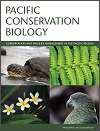
Pacific Conservation Biology
Volume 27 Number 1 2021
PCv27n1_OBTribute to Dr Susan (Sue) Victoria Briggs AM: exceptional practitioner of translating research into policy development and natural resource management (10 June 1950–18 December 2020)
PCv27n1_OB2Tribute to Dr Stephen Davies: ornithologist, conservation biologist and mentor (26 April 1935–29 October 2020)
PC20033Reptiles on the brink: identifying the Australian terrestrial snake and lizard species most at risk of extinction
 , Reid Tingley
, Reid Tingley  , Andrew P. Amey, Hal Cogger, Patrick J. Couper, Mark Cowan, Michael D. Craig, Paul Doughty, Don A. Driscoll, Ryan J. Ellis, Jon-Paul Emery, Aaron Fenner, Michael G. Gardner, Stephen T. Garnett
, Andrew P. Amey, Hal Cogger, Patrick J. Couper, Mark Cowan, Michael D. Craig, Paul Doughty, Don A. Driscoll, Ryan J. Ellis, Jon-Paul Emery, Aaron Fenner, Michael G. Gardner, Stephen T. Garnett  , Graeme R. Gillespie, Matthew J. Greenlees, Conrad J. Hoskin, J. Scott Keogh, Ray Lloyd, Jane Melville
, Graeme R. Gillespie, Matthew J. Greenlees, Conrad J. Hoskin, J. Scott Keogh, Ray Lloyd, Jane Melville  , Peter J. McDonald, Damian R. Michael, Nicola J. Mitchell
, Peter J. McDonald, Damian R. Michael, Nicola J. Mitchell  , Chris Sanderson, Glenn M. Shea
, Chris Sanderson, Glenn M. Shea  , Joanna Sumner
, Joanna Sumner  , Erik Wapstra, John C. Z. Woinarski
, Erik Wapstra, John C. Z. Woinarski  and David G. Chapple
and David G. Chapple 
The first comprehensive assessment of conservation status for Australian terrestrial squamates was undertaken only recently. We used structured expert elicitation to complement and extend this work by identifying the species in most immediate risk of extinction. Of the 60 species assessed, six had high likelihoods of extinction (>50%) in the next 20 years, and up to 11 species could be lost within this timeframe without substantial improvements to current management regimes. Increased resourcing and management intervention are urgently needed to avert future extinctions of Australia’s reptiles.
PC20033 Abstract | PC20033 Full Text | PC20033PDF (450 KB) | PC20033Supplementary Material (138 KB) Open Access Article
PC19045No room to move: bat response to rainforest expansion into long-unburnt eucalypt forest
The expansion of rainforest pioneer trees into long-unburnt open forests is widely reported, yet its effects on insectivorous bat communities is unknown. Examination of open forest with contrasting fire history and levels of rainforest pioneer invasion revealed that increasing rainforest tree density reduced bat activity and species richness. Bat community declines occurred before recommended maximum fire-intervals for dry open forest, suggesting that a review of fire-interval guidelines is warranted.
Bats are keystone species on many Pacific Islands, and many islands support their own endemic species. A significant proportion of these are threatened with extinction, and data on ecology and conservation are lacking for many, especially in remote part of the Pacific. Between 1990 and 2019 we surveyed bats across numerous islands in Torba Province, Vanuatu and Temotu Province Solomon Islands. We present valuable data on the ecology and conservation status of several poorly studied species.
The African carder bee, Pseudoanthidium (Immanthidium) repetitum (Hymenoptera: Megachilidae), is an introduced species in Australia. It was first reported in 2000 and rapidly spread across the east coast. This paper reports the first observations of P. repetitum on the other side of the continent in Western Australia, representing a major range expansion. Potential impacts on native fauna and flora of this species are discussed.
This study reveals important insights into the seasonal movement, interchange and key locations used by fairy terns. The Western Australian fairy tern metapopulation consists of a partially migratory, spring/summer-breeding population and a sedentary, winter-breeding population. Seven management units are proposed to underpin a conservation strategy for this threatened seabird.
This paper examines patterns in flying-fox rescues in New South Wales, Australia. The vulnerable grey-headed flying-fox (Pteropus poliocephalus) accounted for most rescues, which were mostly in coastal regions. Entanglements, heat stress, orphaned pups and electrocutions were dominant causes of flying-foxes coming into care. A high proportion of rehabilitated flying-foxes survived to release.
PC20039Partial clearing of a road corridor leads to homogenisation of the invertebrate fauna
Ants were surveyed along a corridor that had been cleared for an abandoned highway. We surveyed 7 uncleared reference sites and 13 cleared sites that had been rehabilitated 2 years earlier. Species richness was marginally higher in the reference sites and ant abundance was higher in the cleared sites but clearing resulted in homogenisation of the ant assemblages that were associated with the original vegetation associations.
PC19032Tongan socio-environmental spatial layers for marine ecosystem management
 , Sophie E. Gordon
, Sophie E. Gordon  , Alexandra C. Dempsey
, Alexandra C. Dempsey  , Sam J. Purkis
, Sam J. Purkis  , Siola'a Malimali, Tu'ikolongahau Halafihi, Paul C. Southgate
, Siola'a Malimali, Tu'ikolongahau Halafihi, Paul C. Southgate  , Tom C. L. Bridge
, Tom C. L. Bridge  , Robert L. Pressey
, Robert L. Pressey  and Geoffrey P. Jones
and Geoffrey P. Jones 
Here we provide a marine socio-environmental dataset covering Tonga’s near-shore marine ecosystem compiled from various global layers, remote sensing projects, fieldwork, local ministries and national census. The dataset consists of 11 environmental and 6 anthropogenic variables summarised in ecologically relevant ways, spatially overlaid across the near-shore marine ecosystem of Tonga.
This study describes the preferred microhabitat of a population of the threatened grass Arthraxon hispidus growing within a freshwater wetland dominated by Carex gaudichaudiana, and a nursery experiment that identified that A. hispidus plants grew best under waterlogged and poorly drained treatments. These finding have implications for species conservation planning and habitat restoration approaches.



